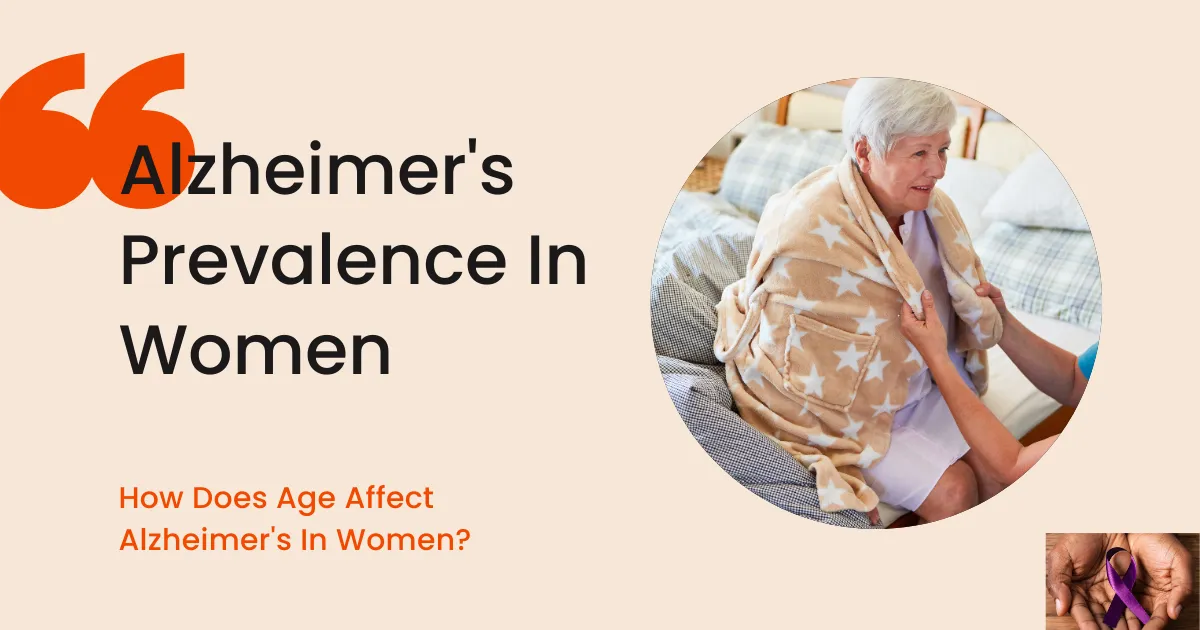Alzheimer’s disease affects women more often than men. Nearly two-thirds of Alzheimer’s patients in the United States are women. This gender disparity is not completely understood but may be related to both biological and social factors. Women tend to live longer than men, and age is a significant risk factor for Alzheimer’s. Additionally, there’s growing evidence that hormonal changes, particularly during menopause, may influence a woman’s susceptibility to Alzheimer’s.
-
Alzheimer's Disease In Women
-
Why Are More Women Affected By Alzheimer's?
- Prevalence in Women
- Age of Onset and Progression
- Hormonal Factors
- Genetic and Biological Differences
- Symptoms and Cognitive Decline
- Treatment Options
- Promising Research
- Behavioral Changes In Female Alzheimer's Patients
- Agitation and Irritability
- Anxiety and Fearfulness
- Sundowning
- Wandering and Disorientation
- Resistance to Care
- Depression and Withdrawal
- Emotional Lability
- Inappropriate Sexual Behavior
- Genetics Of Alzheimer's Disease
-
Why Are More Women Affected By Alzheimer's?
Alzheimer's Disease In Women
Why Are More Women Affected By Alzheimer's?
-
Prevalence in Women
Alzheimer's disease is more prevalent in women, and this gender disparity is a notable aspect of the disease.
-
Age of Onset and Progression
Women typically experience Alzheimer's at an older age than men. This suggests that hormonal factors, such as estrogen, which declines during menopause, could play a role. The disease may progress differently in women, with some studies indicating that women tend to experience a more rapid decline in cognitive function once diagnosed. However, these differences can vary from person to person.
-
Hormonal Factors
Hormonal changes, particularly those related to estrogen, are under investigation for their influence on Alzheimer's risk in women. Estrogen has neuroprotective properties and can affect brain health. Researchers are exploring whether hormone replacement therapy (HRT) during menopause could potentially reduce Alzheimer's risk in women. However, this is still an area of active research with ongoing debates about the risks and benefits of HRT.
-
Genetic and Biological Differences
Genetic and biological factors contribute to the gender disparity in Alzheimer's. The APOE gene, specifically the APOE4 variant, is associated with an increased risk of Alzheimer's, and it may have a more significant impact on women. Additionally, differences in brain structure and function between men and women may influence how the disease develops and progresses.
-
Symptoms and Cognitive Decline
Women with Alzheimer's often exhibit different cognitive symptoms than men. While memory loss is a common early sign for both genders, women may experience more pronounced memory problems. Men, on the other hand, may have greater difficulties with problem-solving and decision-making. These variations highlight the heterogeneity of Alzheimer's and the importance of personalized care.
-
Treatment Options
Alzheimer's treatments, including medications like cholinesterase inhibitors and NMDA receptor antagonists, are not gender-specific. However, the effectiveness of these treatments can vary among individuals, regardless of gender. Personalized treatment plans, including cognitive interventions and lifestyle modifications, are increasingly recognized as important aspects of Alzheimer's care.
-
Promising Research
Ongoing research seeks to better understand the gender differences in Alzheimer's. This includes investigating the role of hormones, genetics, and brain structure. Researchers are also exploring gender-specific interventions and treatment approaches. Promising areas of research include the development of biomarkers that can identify Alzheimer's risk earlier and novel therapies tailored to individual profiles.
In summary, Alzheimer’s disease affects women more frequently than men, and the experience can differ due to age of onset, hormonal factors, and unique symptoms. Female caregivers play a critical role and face distinct challenges. Ongoing research offers hope for improved understanding and personalized care for women with Alzheimer’s.
-
Agitation and Irritability
Many female Alzheimer's patients experience increased agitation, restlessness, and irritability. These behaviors can be triggered by frustration, confusion, or discomfort due to memory loss or difficulties in communication.
-
Anxiety and Fearfulness
Anxiety and fearfulness are prevalent among female Alzheimer's patients. They may become anxious in unfamiliar environments or when they cannot recall certain details, leading to heightened stress levels.
-
Sundowning
Sundowning refers to a pattern of increased confusion, restlessness, and behavioral issues that often occurs in the late afternoon or evening. It can be more pronounced in female Alzheimer's patients, leading to sleep disturbances and nighttime wandering.
-
Wandering and Disorientation
Many female Alzheimer's patients tend to wander, sometimes becoming disoriented and unable to find their way back home. Wandering can be dangerous and is a major concern for caregivers.
-
Resistance to Care
Female Alzheimer's patients may resist personal care tasks such as bathing or changing clothes. This resistance can be due to loss of autonomy or a lack of understanding of the necessity of these activities.
-
Depression and Withdrawal
Depression is common among Alzheimer's patients, including women. Symptoms can include persistent sadness, social withdrawal, and a loss of interest in previously enjoyed activities.
-
Emotional Lability
Emotional lability, characterized by rapid shifts in mood, can be more pronounced in female Alzheimer's patients. They may go from laughter to tears quickly, making emotional support crucial.
-
Inappropriate Sexual Behavior
In some cases, female Alzheimer's patients may display inappropriate sexual behavior, which can be challenging for caregivers to manage. This behavior is typically a result of impaired judgment and a lack of understanding of social norms.
Genetics Of Alzheimer’s Disease
Alzheimer’s disease is a complex neurodegenerative disorder that is influenced by a combination of genetic and environmental factors. While the exact causes of Alzheimer’s disease are still not fully understood, genetic factors have been found to play a significant role in its development.
There are two main types of Alzheimer’s disease: early-onset and late-onset. Early-onset Alzheimer’s disease is relatively rare and is usually caused by mutations in specific genes. These mutations can be inherited from one or both parents and are typically responsible for the disease manifesting before the age of 65.
Late-onset Alzheimer’s disease, which is the most common form, is believed to be influenced by a combination of genetic and environmental factors. The most well-known genetic risk factor for late-onset Alzheimer’s is the apolipoprotein E (APOE) gene. There are three forms of the APOE gene: APOE2, APOE3, and APOE4. APOE4 is considered a risk factor for the development of Alzheimer’s disease, while APOE2 is associated with a reduced risk.
Having one copy of the APOE4 gene increases the risk of developing Alzheimer’s disease, and having two copies further increases the risk. However, it is important to note that not everyone with the APOE4 gene will develop Alzheimer’s disease, and not everyone without the gene will be protected from it. Other genetic variations and interactions with environmental factors likely contribute to the overall risk.
In addition to the APOE gene, several other genes have been identified that may increase the risk of developing Alzheimer’s disease. These include genes involved in the production and processing of amyloid-beta protein, such as the presenilin 1 (PSEN1) and presenilin 2 (PSEN2) genes. Mutations in these genes can lead to the accumulation of amyloid-beta plaques in the brain, a hallmark characteristic of Alzheimer’s disease.
It is important to note that while genetics can increase the risk of developing Alzheimer’s disease, they do not guarantee its occurrence. Other factors, such as age, overall health, lifestyle choices, and environmental influences, also contribute to the development and progression of the disease. Ongoing research is focused on further understanding the genetic and environmental factors involved in Alzheimer’s disease to develop effective prevention and treatment strategies.
Coming Soon:
Behavioral Changes In Male Alzheimer’s Patients
Challenges Faced By Daughters Caring For Alzheimer’s Parents
Share this:
- Click to share on Facebook (Opens in new window) Facebook
- Click to share on Pinterest (Opens in new window) Pinterest
- Click to share on LinkedIn (Opens in new window) LinkedIn
- Click to share on X (Opens in new window) X
- Click to share on Tumblr (Opens in new window) Tumblr
- Click to share on Bluesky (Opens in new window) Bluesky


Pingback: walter
Pingback: Stem Cell Therapy Vs. Traditional Alzheimer's Treatments
Pingback: The Secrets To A Brain-healthy Life With Engaging Puzzles
Pingback: Symptoms of Prediabetes in Both Genders
Pingback: Spotting the Danger: 7 Key Symptoms of High BP Emergencies